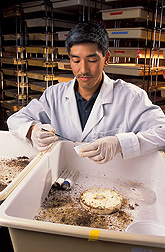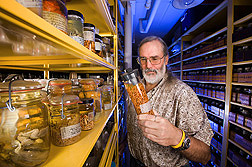Archiving Parasites and Protozoa
for Research, Diagnoses, and More
|
|
In the United States, parasitic infections contribute to losses of more than $2 billion annually in livestock alone. In turn, some parasites, like tapeworm, can infect humans who eat uncooked or undercooked beef or pork.
Fortunately, ARS maintains archival collections of parasites for research, identification, and diagnostic purposes, the vast majority of which are held at the U.S. National Parasite Collection (USNPC), which is curated by ARS zoologist Eric Hoberg.
Hoberg is with the Animal Parasitic Diseases Laboratory, which is part of the Henry A. Wallace Beltsville Agricultural Research Center in Beltsville, Maryland. The collection was established in 1892 and is among the largest parasite collections in the world.
Current holdings include more than 20 million catalogued specimens representing nematodes, tapeworms, flukes, spiny-headed worms, and some parasitic arthropods, such as fleas, ticks, and lice. Detailed biodiversity information about hosts and geographic distribution is maintained in an on-line database.
The USNPC contributes significantly to explorations of diversity, evolution, and distribution, furthering our understanding of the socioeconomic and ecological significance of parasites and pathogens. Archival collections serve as critical baselines to understand ecological disturbance. Archives provide a foundation to identify shifting geographic and host ranges for parasites and diseases that may emerge with accelerated global change.
|
|
Newly Reclassified Protozoa at Work
ARS researchers have also assembled and maintain invertebrate protist collections at three research locations for the purpose of in-house and joint projects.
At the Center for Medical, Agricultural, and Veterinary Entomology (CMAVE), in Gainesville, Florida, researchers are using a collection of microsporidia—formerly classified as protozoa and now considered fungi—to act as soldiers of biological warfare at the tiniest level. Species of these spore-producing parasites, such as Kneallhazia solenopsae, are being used to bring about declines in red imported fire ant (Solenopsis invicta) populations. In Argentina, these infectious soldiers are associated with localized declines of 53 percent to 100 percent in fire ant populations, according to CMAVE entomologist David Oi.
In addition, Oi and CMAVE colleagues Sanford Porter and Steven Valles were able to get K. solenopsae to infect phorid flies without harming them. That’s important because the flies may serve as vectors to infect red imported fire ants with the microsporidia—perhaps facilitating the spread of infection to other colonies.
K. solenopsae not only reduces fire ant colony size, it also reduces the number of reproducing ants, decreases the survival of queens, and increases the mortality rate of colonies, says Oi. The collection enables scientists to research the potential for using these and other microbes as biocontrol agents.
In Sidney, Montana, ARS scientists at the Northern Plains Agricultural Research Laboratory used the U.S. Rangeland Grasshopper Collection’s microsporidia holdings to develop the first microbial control agent registered for use in the United States against grasshoppers. Large-scale outbreaks of grasshoppers occur about every 8 to 10 years. In 2001, such an outbreak caused an estimated $25 million of damage to crops in Utah alone.
And researchers at the Grain Marketing and Production Research Center in Manhattan, Kansas, maintain protozoa in a collection that is used to develop biocontrol agents against beetles and other bugs that burrow into stored grain products.—By Rosalie Marion Blissand Sharon Durham, Agricultural Research Service Information Staff.
This research is part of Animal Health, an ARS national program (#103) described at www.nps.ars.usda.gov.
Eric P. Hoberg is in the USDA-ARS Animal Parasitic Diseases Laboratory, 10300 Baltimore Ave., Bldg. 1180, Beltsville, MD 20705-2350; (301) 504-8588.
David Oi is in the USDA-ARS Center for Medical, Agricultural, and Veterinary Entomology, 1600 S.W. 23rd Dr., Gainesville, FL 32608; (352) 374-5987.
"Archiving Parasites and Protozoa for Research, Diagnoses, and More" was published in the January 2010 issue of Agricultural Research magazine.








